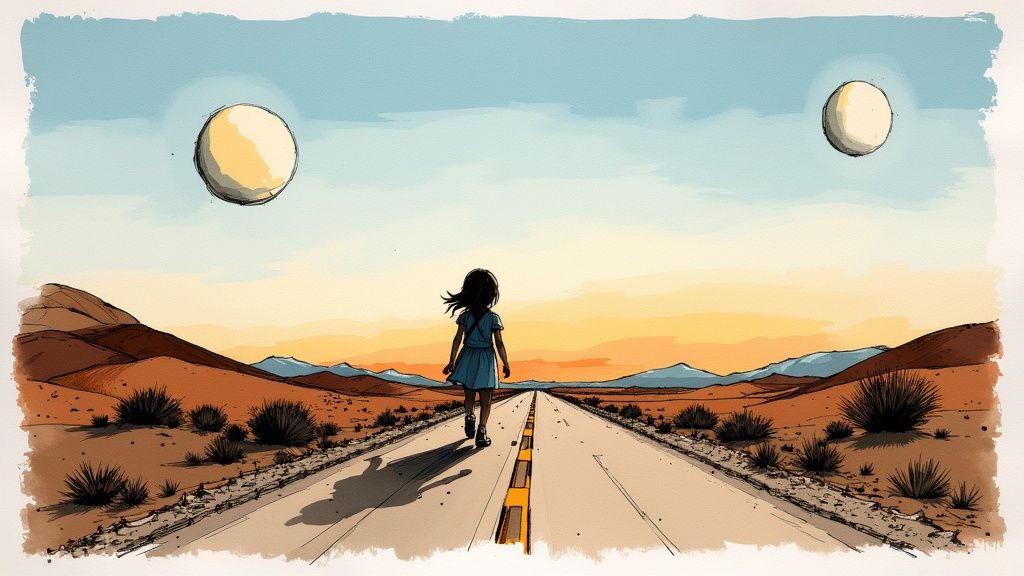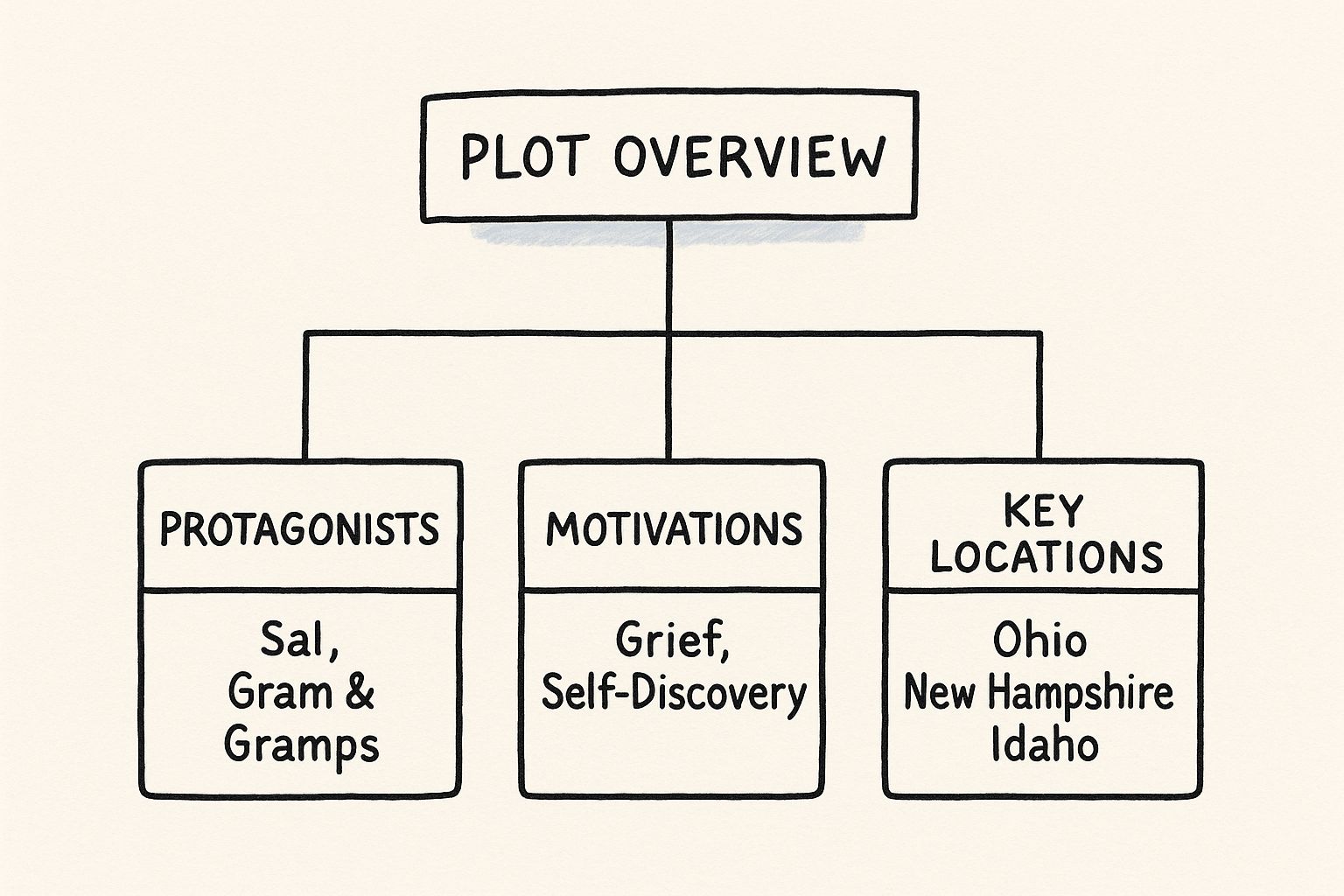Walk Two Moons is a powerful young adult novel by Sharon Creech that introduces us to Salamanca "Sal" Tree Hiddle, a thirteen-year-old girl on a cross-country trip with her grandparents. But this is far more than just a road trip; it's an emotional quest. Sal is retracing her mother's journey from Ohio to Idaho, hoping to understand why she left.
Embarking on the Journey of Walk Two Moons

At its heart, this book is a story within a story. As Sal and her wonderfully eccentric grandparents drive, she passes the time by telling them a winding tale about her friend, Phoebe Winterbottom. Phoebe’s seemingly perfect life gets turned upside down when her own mother mysteriously disappears, forcing Phoebe to face a world she never knew existed.
This clever storytelling structure is really the engine of the novel. By talking about Phoebe’s drama, Sal gets to process her own grief and confusion from a safe emotional distance. Phoebe's story becomes a mirror, reflecting Sal's own unspoken feelings about her mother.
A Legacy of Recognition
Published in 1994, Walk Two Moons quickly found its place as one of the most celebrated children’s novels of its time. It won the prestigious Newbery Medal in 1995, a huge honor given to just one American children's book each year. This award alone solidified its spot in classrooms and libraries, but the recognition didn't stop there. The novel also earned international praise, including the United Kingdom Reading Association Award and the UK’s Children’s Book Award, which just goes to show its universal emotional pull.
Core Ideas and Lasting Impact
The novel’s enduring appeal comes from how it explores complex, universal themes in a way that feels completely real and accessible. It masterfully navigates the messy realities of loss, the deep importance of empathy, and the healing power of storytelling itself. Its central message is perfectly captured in a proverb that weaves through the entire narrative:
"Don't judge a man until you've walked two moons in his moccasins."
This simple idea invites readers to step into someone else's life, fostering a profound sense of understanding. It's a key reason why the book remains a staple in schools, often appearing on lists of essential 5th grade novels that teach valuable life lessons. Through Sal’s journey—both the one on the road and the one in her stories—we learn that every person has a complex history and that real compassion is the key to connection.
Understanding the Two Interwoven Stories
The real magic of Walk Two Moons is how it tells its story—or rather, its stories. It’s structured like a set of Russian nesting dolls, with one narrative tucked neatly inside another. This unique approach is the engine that drives the entire plot, allowing Sharon Creech to dig into some really complex emotions with a masterful touch.
At the top layer, we have what's called the frame story. This is the book's "present day," following thirteen-year-old Salamanca "Sal" Tree Hiddle on a cross-country road trip. She’s traveling from Ohio to Idaho with her wonderfully quirky grandparents, Gram and Gramps Hiddle, on a mission to see her mother before her birthday. This physical journey across the American landscape is the container for everything else that happens.
The Story Within the Story
As they drive, Sal passes the time by telling her grandparents a long, winding tale about her friend back in Ohio, Phoebe Winterbottom. This becomes the inner story. Phoebe's world is full of melodrama and mystery—and quite a bit of humor, too. Her perfectly ordered life gets turned upside down when her mother suddenly vanishes, leaving only a few cryptic notes behind.
But Phoebe’s story isn't just a distraction for a long car ride; it serves a much deeper purpose for Sal. By recounting Phoebe's confusion and her wild theories about her mother’s disappearance, Sal can begin to process her own feelings of loss without having to face them head-on.
This visual breaks down how these layered narratives are fueled by different emotional drivers.

You can see clearly how Sal’s personal journey is all about her grief and a search for understanding, connecting her past in Ohio with her ultimate destination in Idaho.
How the Narratives Mirror Each Other
The true power of this storytelling method is how Phoebe’s experiences hold up a mirror to Sal’s own life. Almost every major event in the inner story has an echo in the outer one, which creates incredible depth for the reader.
- Disappearing Mothers: At the heart of it all, both Sal and Phoebe are dealing with the sudden absence of their mothers. It’s a shared trauma that connects them, even though their circumstances are very different.
- Confronting the Unknown: Phoebe’s over-the-top search for a "lunatic" and her suspicions about her father’s secrets are really just a reflection of Sal's own deep-seated fears about her family.
- The Journey to Acceptance: As Phoebe is slowly forced to accept a complicated truth about her own family, Sal inches closer to confronting the heartbreaking reality of her mother’s story.
By telling Phoebe’s story, Sal is literally "walking two moons in her moccasins." It's her way of trying to understand someone else's pain to make sense of her own. This process is a key part of what makes stories so powerful, and teachers can find fantastic resources for building these skills by exploring various reading comprehension strategies for teachers.
To see how these two plots run side-by-side, let's look at some key moments.
Key Plot Points in Walk Two Moons
| Event | Sal's Journey (Frame Story) | Phoebe's Story (Inner Story) |
|---|---|---|
| Inciting Incident | Sal and her grandparents leave Ohio on their urgent road trip to Idaho. | Phoebe's mother disappears, leaving behind cryptic notes. |
| Rising Action | Sal reflects on her mother leaving, her father's grief, and her move to Ohio. | Phoebe and Sal investigate the "lunatic" and Mr. Winterbottom's secrets. |
| Midpoint | A stop at the Badlands leads to a medical emergency with Gram. | The truth about Mrs. Winterbottom and her secret son is revealed. |
| Climax | Sal arrives in Idaho and finally faces the truth about her mother's fate. | Phoebe confronts her mother and begins to accept her family's new reality. |
These parallel tracks aren't just a clever literary device; they allow the reader to discover the truth right alongside Sal.
The two plots are not separate—they are woven together so tightly that they become one. As the road trip gets closer to Idaho, Sal and Phoebe's stories start to converge. The emotional wall Sal has built begins to crumble, and the parallels between her life and her friend’s become impossible to miss. This masterful buildup leads to the novel's climax, where the truth of Sal's journey is finally revealed, delivering an emotional punch that has resonated with readers for decades.
Meeting the Unforgettable Characters

The characters in Walk Two Moons are what make the story stick with you long after you've finished the last page. They breathe life into its powerful themes of love, loss, and empathy. Every single person Sal meets on her journey—both on the road trip and in the stories she tells—has a crucial part to play.
We don't meet these people as simple, one-dimensional figures. They're in motion, changing and growing right alongside Sal. They’re flawed, funny, and deeply real, which is exactly why they’ve remained so beloved by readers for decades.
Salamanca Tree Hiddle
At the heart of it all is Salamanca 'Sal' Tree Hiddle, our thirteen-year-old narrator. Sal is a tough, thoughtful “country girl” who feels a deep connection to the natural world and her family’s roots. Her whole identity is tangled up with the land, the trees, and the memory of her mother.
Sal's trip isn't just a drive across the country. It’s an emotional pilgrimage to piece her life back together after her mother leaves. She uses storytelling as a kind of armor, keeping her own overwhelming pain at a distance by focusing on her friend Phoebe’s drama. Through her eyes, we watch a young girl wrestle with grief, denial, and the painfully slow process of coming to terms with reality.
Gram and Gramps Hiddle
Sal’s paternal grandparents, Gram and Gramps Hiddle, are the story's warm, beating heart. They’re the quirky, loving engine of the road trip, and their eccentric behavior hides a deep well of wisdom and an unbreakable bond. Gramps is the kind, steady hand on the steering wheel, while Gram is spontaneous and full of life, collecting souvenirs and embracing every single moment.
Their personalities seem like total opposites, but they fit together perfectly.
- Gramps: He’s protective, patient, and the quiet anchor for the family. His deep love for his "chickabiddy," Gram, is the story's romantic center.
- Gram: Vivacious and curious, she’s always exclaiming "Huzza, huzza!" at new discoveries. Her wide-eyed wonder at the world teaches Sal how to find moments of joy, even in the middle of sorrow.
Together, they create a safe, loving space for Sal to finally face her past, offering her a powerful example of what an enduring partnership looks like.
Phoebe Winterbottom
Sal's best friend back in Ohio, Phoebe Winterbottom, is a character of wonderful contradictions. She’s prim and proper but also wildly dramatic, seeing "lunatics" and conspiracies lurking around every corner. Her perfectly ordered world completely falls apart when her mother mysteriously disappears, sending Phoebe into a spiral of suspicion and anxiety.
But Phoebe is so much more than just a sidekick; she’s Sal’s mirror image. Her story reflects Sal's own unspoken fears about her mother in a more theatrical, over-the-top way.
By telling Phoebe's frantic story, Sal gets to explore her own questions about abandonment and family secrets from a safe distance. Phoebe’s journey to accept a complicated truth about her mother runs in a direct parallel to Sal’s own path toward a devastating revelation.
This clever storytelling trick is the core mechanism of Walk Two Moons. It lets Sal—and us—process profound grief through the lens of someone else's experience.
Chanhassen Hiddle and the Supporting Cast
Although she isn't physically there for most of the novel, Sal’s mother, Chanhassen 'Sugar' Hiddle, is everywhere. Her memory haunts every single page, brought to life through Sal's stories of a vibrant, nature-loving woman who seemed to have a song in her heart. Figuring out who she really was is like solving a puzzle, as Sal slowly reveals the sadness and complexity that led her to leave.
Other key people add more layers to Sal's world:
- Ben Finney: He's Sal’s quirky and kind-hearted classmate. His awkward charm and artistic soul give Sal a glimpse of first love and a real connection outside of her family’s pain.
- Margaret Cadaver: Sal’s father's new friend, whose last name alone makes her suspicious in Sal's eyes. She represents the difficult reality that life moves on, and her true connection to Sal's mother is one of the book's most shocking and heartbreaking twists.
Each of these characters weaves a vital thread into the rich tapestry of Walk Two Moons. They all prove that every person has a story filled with hidden sorrows and unexpected joys, driving home the novel's ultimate message: never judge someone until you've walked two moons in their moccasins.
Unpacking the Core Themes and Symbols
Walk Two Moons is a book that’s built on layers of meaning. On the surface, it’s a cross-country road trip, but underneath, simple objects and repeated phrases begin to carry a massive emotional weight. Sharon Creech has woven a rich tapestry here, and by exploring its core themes and symbols, we can really start to see the full picture.
The entire story is built around a single, powerful idea—a proverb that shows up on Phoebe’s doorstep and follows Sal all the way to Idaho.
"Don't judge a man until you've walked two moons in his moccasins."
This isn't just some quaint piece of advice; it's the very backbone of the novel. Sal’s entire narration is her attempt to live out this proverb. By telling Phoebe’s story, she’s literally walking in her friend’s moccasins. This gives her a safe distance to process her own grief, and in doing so, she finds empathy not just for Phoebe, but for her parents and, most importantly, for herself.
The Heavy Weight of Grief
In Walk Two Moons, grief isn't a single, neat emotion. It's messy, confusing, and complicated. Sal cycles through denial, anger, and a deep, profound sadness, all while trying to put on a brave face for everyone around her. Her road trip is a physical expression of this internal battle as she races against the clock, clinging to a desperate hope she can barely admit to herself.
The novel makes it clear that grief isn’t something you just “get over.” It’s something you learn to carry with you. We see Sal's father almost paralyzed by his sorrow, and Phoebe’s family can’t even find the words to talk about their feelings. The story’s real power comes from this honest look at how loss can break a family apart, and how the simple act of telling a story can start to piece it back together.
The Healing Power of Stories
Storytelling is so much more than a hobby in this book—it's a survival tool. For Sal, recounting Phoebe’s over-the-top tale to her grandparents creates a space where she can face her own trauma without looking at it directly. It’s like trying to look at the sun; it's safer to catch glimpses of it through a pinhole.
This is a profound truth about how we heal. When we share our own experiences and truly listen to others, we find connection and realize we aren't alone in our pain. The stories swapped between Sal, Gram, and Gramps become the glue that holds them together on that long drive, turning a trip born from tragedy into a journey of shared understanding. As we unpack these themes, it's worth exploring the power of imagery in literature to see how Creech brings these ideas to life.
The Symbols That Tell the Story
Creech is a master at using recurring symbols to add depth to the novel's emotional world. These aren’t just random details; they are loaded with meaning and connect Sal to her past, her mother, and her sense of self.
-
The Singing Trees: Back on her family's farm in Bybanks, Kentucky, the trees aren't silent for Sal. She hears them sing—a special connection she shared with her mother. The trees stand for her heritage, her deep bond with the natural world, and the spiritual presence of her mom that she carries with her.
-
Sal's Long Hair: Sal's long, black hair is a powerful symbol of both her identity and her grief. Before her mother left, she would brush and braid it for her. After she was gone, Sal refused to cut it, letting it grow as a tangible, physical link to her mother and the life she lost.
-
The Road Trip: The journey itself is the biggest metaphor in the entire book. It’s a literal drive from Ohio to Idaho, but it's also a symbolic journey from denial to acceptance. Each stop along the way, from the Badlands to Old Faithful, marks a new step in Sal's emotional growth, pulling her closer to the heartbreaking truth waiting for her at the end of the road.
The novel’s impact in the classroom is undeniable, especially in the way it teaches these complex ideas. Its inclusion in school curricula across the country is a testament to how well it fosters empathy. The central proverb is now a staple in character education programs, helping students explore different kinds of families and the importance of seeing things from another's perspective. It's estimated that over 1 million students worldwide have read the book in school since it was published. This focus on "walking in another's moccasins" also highlights why representation in children's books is so incredibly important for young readers.
Why Walk Two Moons Remains a Classic

Decades after it first hit the shelves, Walk Two Moons has done more than just win awards. It’s earned a permanent spot in the hearts of readers and on classroom reading lists everywhere. Its staying power comes from its incredible ability to work on so many levels at once—it’s both a gut-wrenching emotional journey and a masterclass in how to tell a story.
The book’s structure is a huge part of its genius. The story-within-a-story format makes tricky literary ideas like frame narratives and foreshadowing completely accessible, even for younger readers.
They don't just get a definition of a frame narrative; they get to see it unfold as Sal weaves Phoebe's wild tale into the fabric of her own cross-country road trip. This makes the book a perfect teaching tool, showing sophisticated storytelling in a way that feels organic and captivating, not like a stuffy textbook lesson.
A Gateway to Difficult Conversations
Beyond its literary cleverness, Walk Two Moons has become an essential book for opening up conversations about tough, real-world topics. The story never shies away from life's messy realities, offering a gentle but honest way into discussions that can be hard for kids and adults to start.
The book creates a safe space to explore sensitive issues that touch so many families:
- Grief and Loss: Sal's entire journey is a deep dive into how a family grapples with the death of a loved one. The novel shows that grieving is a complicated, non-linear process, and that's okay.
- Family Dysfunction: Through both Sal’s and Phoebe’s families, the book makes it clear that no family is perfect. It looks at everything from parental depression to the secrets people keep and the strain it all puts on kids.
- Mental Health: The story gently touches on the quiet, internal struggles that can make a person feel overwhelmed, offering a window into why the mothers in the story had to leave. It builds a powerful sense of empathy for battles we can't always see.
By handling these subjects with such care and nuance, the novel helps young readers build their own emotional intelligence. It teaches them that it's normal to have complicated feelings and that talking about them is the first step toward understanding.
From the Page to the Stage
The enduring power of Walk Two Moons has even leaped from the page to the stage. A successful theater adaptation has brought Sal’s journey to life for a whole new generation, proving its themes are just as powerful in a different medium. This has helped the story's core messages reach even more people in schools and community theaters.
The play, adapted by Tom Arvetis, really nails the novel's unique blend of humor and heartbreak. It’s proof that the story's emotional core resonates just as strongly in a live performance.
This theatrical version isn't just a side note; it's been recognized for its own artistic and educational value. The stage adaptation of Walk Two Moons is performed in an estimated 50+ productions each year across the U.S. and even received the AATE Distinguished Play Award. Its flexible cast size makes it a great fit for all kinds of theater groups. You can learn more about licensing the award-winning play on the official Dramatic Publishing page.
In the end, Walk Two Moons is a classic because it pulls off something truly special. It tells a deeply personal story that somehow feels universal, wrapping profound lessons about life, loss, and empathy in a tale that is both heartbreaking and hopeful. It isn't just a book kids are assigned to read; it’s an experience that sticks with them, shaping how they see the world and the people in it.
Questions for Deeper Discussion
Once you turn the final page of Walk Two Moons, the story doesn't just end—it stays with you. The book's rich emotional world and clever storytelling make you want to dig deeper into its characters and the powerful messages tucked inside. The questions that follow are meant to go beyond just remembering the plot, making them perfect for a book club, the classroom, or even just thinking on your own.
These prompts are designed to get you thinking about the characters' choices, what drove them, and the masterful way Sharon Creech weaves her two stories together. They’re a starting point for connecting the novel’s big ideas to our own lives, helping us appreciate its brilliant writing and lasting lessons.
Analyzing the Narrative Structure
One of the most unique things about Walk Two Moons is how it tells two stories at once. Sal’s road trip with her grandparents is the main frame, but inside that story, she’s telling us all about Phoebe Winterbottom. This isn't just a fancy literary device; it's the key to understanding Sal's journey.
Let's think about that:
- How well does the story-within-a-story work for you? Does hearing about Phoebe slow things down, or does it add to Sal's main story?
- What if the book had been told in a straight line, from beginning to end, without the Phoebe parts? How would that have changed the gut-punch of the final reveal about Sal's mother?
- When did you first start to guess what Sal's trip to Idaho was really about? What little clues did the author leave for us along the way?
Character Motivations and Choices
The people in this novel are driven by complicated feelings that aren't always out in the open. Their actions can be messy and confusing, which is exactly what makes them feel so real. Figuring out why they do what they do is the key to unlocking the heart of the story.
The old saying, "Don't judge a man until you've walked two moons in his moccasins," is at the core of this book and applies to everyone in it. It’s a challenge to look past what people do on the surface and see the grief, fear, or love that’s really pushing them.
Think about the tough decisions made in the story. Why did Sal’s mother feel like she had to go? Was Phoebe’s mother right to leave and reconnect with her son? And what about Margaret Cadaver—was she a good or bad influence on Sal’s father?
Exploring Themes and Symbolism
Walk Two Moons is filled with symbols that give the story extra layers of meaning. Nature, especially, is a huge part of how Sal stays connected to her heritage and her mother's memory.
- The Singing Trees: What do you think the "singing trees" meant to Sal? How does feeling close to nature help her deal with her sadness?
- Sal's Hair: Sal’s long black hair is such a powerful image. What does it stand for, and why is her decision about it at the end of the book so important?
- The Journey: The road trip is obviously a big deal. But besides the miles on the road, what other kinds of journeys are Sal, Gram, and Gramps on?
For teachers using these questions in class, it’s always important to know if students are really grasping the material. Using good formative assessment strategies can help you see what’s clicking and what’s not, so you can make sure everyone gets the most out of these rich discussions.
At Number 6 Publishing, we believe stories like Walk Two Moons are essential for building empathy and curiosity. Explore our curated book lists and find your next unforgettable read at https://www.number6publishing.com.
